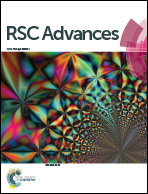Structural, magnetic and theoretical investigations on the magnetocaloric properties of La0.7Sr0.25K0.05MnO3 perovskite
Abstract
The La0.7Sr0.25K0.05MnO3 (LSKMO0.05) manganite compound was synthesized by the solid state reaction method. X-ray diffraction analysis revealed that this sample crystallizes in the distorted rhombohedral system with the R![[3 with combining macron]](https://www.rsc.org/images/entities/char_0033_0304.gif) c space group. The magnetic study showed a second order paramagnetic (PM)-ferromagnetic (FM) transition at the Curie temperature TC = 332 K. In addition, isothermal measurements of magnetization allowed us, through thermodynamic Maxwell relations, to determine the magnetic entropy change (ΔSM). The maximum magnetic entropy change (ΔSmax) and the relative cooling power (RCP) were found to be, respectively, 2.37 J kg−1 K−1 and 102 J kg−1 for a 2 T magnetic field change along with a negligible hysteresis loss, making this material a promising candidate for magnetic refrigeration. In order to eliminate the drawbacks due to the use of multistep nonlinear fitting in a conventional manner, the field dependence of magnetic entropy change was applied to study the critical behavior. As expected, our results are consistent with the values derived for the 3D-Heisenberg model.
c space group. The magnetic study showed a second order paramagnetic (PM)-ferromagnetic (FM) transition at the Curie temperature TC = 332 K. In addition, isothermal measurements of magnetization allowed us, through thermodynamic Maxwell relations, to determine the magnetic entropy change (ΔSM). The maximum magnetic entropy change (ΔSmax) and the relative cooling power (RCP) were found to be, respectively, 2.37 J kg−1 K−1 and 102 J kg−1 for a 2 T magnetic field change along with a negligible hysteresis loss, making this material a promising candidate for magnetic refrigeration. In order to eliminate the drawbacks due to the use of multistep nonlinear fitting in a conventional manner, the field dependence of magnetic entropy change was applied to study the critical behavior. As expected, our results are consistent with the values derived for the 3D-Heisenberg model.


 Please wait while we load your content...
Please wait while we load your content...